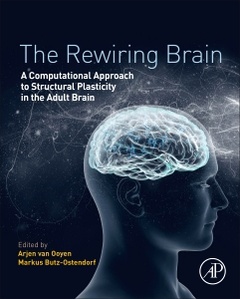The Rewiring Brain A Computational Approach to Structural Plasticity in the Adult Brain
Coordonnateurs : van Ooyen Arjen, Butz-Ostendorf Markus

The adult brain is not as hard-wired as traditionally thought. By modifying their small- or large-scale morphology, neurons can make new synaptic connections or break existing ones (structural plasticity). Structural changes accompany memory formation and learning, and are induced by neurogenesis, neurodegeneration and brain injury such as stroke.
Exploring the role of structural plasticity in the brain can be greatly assisted by mathematical and computational models, as they enable us to bridge the gap between system-level dynamics and lower level cellular and molecular processes. However, most traditional neural network models have fixed neuronal morphologies and a static connectivity pattern, with plasticity merely arising from changes in the strength of existing synapses (synaptic plasticity). In TheRewiring Brain, the editors bring together for the first time contemporary modeling studies that investigate the implications of structural plasticity for brain function and pathology. Starting with an experimental background on structural plasticity in the adult brain, the book covers computational studies on homeostatic structural plasticity, the impact of structural plasticity on cognition and cortical connectivity, the interaction between synaptic and structural plasticity, neurogenesis-related structural plasticity, and structural plasticity in neurological disorders.
Structural plasticity adds a whole new dimension to brain plasticity, and TheRewiring Brain shows how computational approaches may help to gain a better understanding of the full adaptive potential of the adult brain. The book is written for both computational and experimental neuroscientists.
1. Structural plasticity and cortical connectivity
2. Structural plasticity induced by adult neurogenesis
3. Structural neural plasticity during stroke recovery
4. Is lesion-induced synaptic rewiring driven by activity homeostasis?
Section 2. Homeostatic Structural Plasticity
5. Network formation through activity-dependent neurite outgrowth: a review of a simple model of homeostatic structural plasticity
6. Clustered arrangement of inhibitory neurons can lead to oscillatory dynamics in a model of activity-dependent structural plasticity
7. A detailed model of homeostatic structural plasticity based on dendritic spine and axonal bouton dynamics
8. Critical periods emerge from homeostatic structural plasticity in a full-scale model of the developing cortical column
9. Lesion-induced dendritic remodeling as a new mechanism of homeostatic structural plasticity in the adult brain
Section 3. Structural Plasticity and Connectivity
10. The role of structural plasticity in producing nonrandom neural connectivity
11. Structural plasticity and the generation of bidirectional connectivity
12. Spike-timing dependent structural plasticity of multi-contact synaptic connections
13. Selection of synaptic connections by wiring plasticity for robust learning by synaptic weight plasticity
Section 4. Structural Plasticity and Learning and Memory
14. Within a spine’s reach
15. Impact of structural plasticity on memory capacity
16. Long-term information storage by the interaction of synaptic and structural plasticity
17. Impact of structural plasticity on memory formation and decline
Section 5. Neurogenesis-Related Structural Plasticity
18. Adult neurogenesis and synaptic rewiring in the hippocampal dentate gyrus
19. Modifications in network structure and excitability may drive differential activity dependent integration of granule cells into Dentate Gyrus circuits during normal and pathological adult neurogenesis
20. Computational perspectives on adult neurogenesis
21. Restricted Boltzmann Machine models of hippocampal coding and neurogenesis
Section 6. Structural Plasticity and Pathology
22. Modeling the impact of lesions in the brain
23. Network models of epilepsy-related pathological structural and functional alterations in the dentate gyrus
24. Computational models of stroke recovery
25. Neural plasticity in human brain connectivity: the effects of deep brain stimulation
Advanced graduate students and researchers in the fields of computational neuroscience, experimental neuroscience, neurobiology, and computer science
Markus Butz-Ostendorf, Ph.D.
Markus Butz-Ostendorf studied informatics and biology and holds a PhD in neuroanatomy. He did several postdocs at e.g. at the Bernstein Center for Computational Neuroscience Göttingen, the Neuroscience Campus VU Universiteit Amsterdam and the Forschungszentrum Jülich. His research focus is on modeling structural plasticity in the healthy and diseased brain. Together with Arjen van Ooyen, he phrased a computational theory on the driving forces for homeostatic structural plasticity following brain lesions. The underlying algorithms are freely available in the modeling framework for large-scale spiking neuronal networks NEST. He recently edited Frontiers Research Topic "Anatomy and plasticity in large-scale neuronal networks."
- Reviews the current state of knowledge of structural plasticity in the adult brain
- Gives a comprehensive overview of computational studies on structural plasticity
- Provides insights into the potential driving forces of structural plasticity and the functional implications of structural plasticity for learning and memory
- Serves as inspiration for developing novel treatment strategies for stimulating functional repair after brain damage
Date de parution : 06-2017
Ouvrage de 592 p.
19x23.3 cm
Thèmes de The Rewiring Brain :
Mots-clés :
Activity homeostasis; Activity-dependent growth model; Adult neurogenesis; Axonal sprouting; Barnes-Hut algorithm; Bidirectional connections; Boundary vector cells; CAMKII; Catastrophic forgetting; Cell differentiation; Clustering; Compartmental modeling; Compensation; Computational neural model; Computer simulations; Connectivity; Connectomics; Correlation; Correlation detection; Cortex; Cortical column; Cortical remapping; Cortical reorganization; Cortical rewiring; Critical period; Criticality; Deep brain stimulation; Degenerative disorders; Dendrites; Dendritic elongation; Dendritic nonlinearities; Dendritic retraction; Dendritic spine; Dendritic spines; Dentate Gyrus; Dentate granule cell; Dentate granule cell (DGC); Dentate granule cells; Dentate gyrus; Dentate gyrus (DG); Development; Dynamic networks; Effectual connectivity; Entorhinal cortex; Epilepsy; Excitation-inhibition balance; Fast ripples; Filopodia dynamics; Focal retinal lesions; Functional recovery; Granule cell (GC); Granule cells; Graph theory; Grid cells; Hebbian learning; Hebbian plasticity; High frequency oscillations; Hippocampus; Homeostasis; Homeostatic plasticity; Hub cells; Hysteresis; Inhibition-inhibition connectivity; Inhibitory plasticity; Input clustering; Interictal spikes; Large-scale neuronal network model; Learning; Lesions; Long-term memory; Mathematical models; Memory; Memory capacity; Memory consolidation; Morphological modeling; Motor skill learning; Multiple synaptic contacts; Multisynaptic connections; Muscle synergy; Network; Network formation; Networks; Neural circuit; Neural decoding; Neural development; Neural networks; Neurite outgrowth; Neurodegeneration; Neurogenesis; Neuroimaging; Neuromorphic computing; Neuronal network model; Neurons; Neurorealistic simulation; Olfactory bulb (OB); Periglomerular cell (PGC); Phase response curves; Plasticity; Potential synapse; Proactive interference



